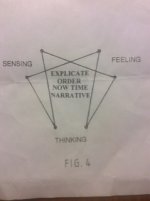Pionart
Well-known member
- Joined
- Sep 17, 2014
- Messages
- 4,024
- MBTI Type
- NiFe
So I am trying to understand what these functiony things be doing.
A function takes in information, does something to the information, then outputs a results.
Cognitively there are 4 different functions with 2 different attitude for each.
I envision these functions as being like a ball, containing the essential features of what the individual knows about that function in the abstract.
So for an introverted function, it processes information like this: information comes in, then the function-ball identifies the basic form of the information in terms of whatever of the four functions it happens to be, e.g. Ti will extract the basic logical formula underlying something. Since many different kinds of information will activate the same Thinking-complex, when Ti extracts the form of some information, it will be immediately linked to another set of information with the same basic Thought-form.
I'm an introvert so introverted use of a function is easier for me to grasp.
For extroverted function I think it is something like this: there will be some information in the environment, and, using the forms from the function-ball, the individual will impose a particular kind of of form onto the information, for example Te will impose a logical/conceptual structure onto the information in question. The information will be re-organised so it fits into a conceptual scheme.
Can anyone tell me more about what extroverted functions do exactly?
I am also seeking a stripped down version of what kinds of features it is exactly that each of the N/S/F/T functions are using, like what the essential property is of each of the four function-balls and the energy fields that the information is divided into.
Then I will try to describe and identify functions because at the moment I have no idea.
A function takes in information, does something to the information, then outputs a results.
Cognitively there are 4 different functions with 2 different attitude for each.
I envision these functions as being like a ball, containing the essential features of what the individual knows about that function in the abstract.
So for an introverted function, it processes information like this: information comes in, then the function-ball identifies the basic form of the information in terms of whatever of the four functions it happens to be, e.g. Ti will extract the basic logical formula underlying something. Since many different kinds of information will activate the same Thinking-complex, when Ti extracts the form of some information, it will be immediately linked to another set of information with the same basic Thought-form.
I'm an introvert so introverted use of a function is easier for me to grasp.
For extroverted function I think it is something like this: there will be some information in the environment, and, using the forms from the function-ball, the individual will impose a particular kind of of form onto the information, for example Te will impose a logical/conceptual structure onto the information in question. The information will be re-organised so it fits into a conceptual scheme.
Can anyone tell me more about what extroverted functions do exactly?
I am also seeking a stripped down version of what kinds of features it is exactly that each of the N/S/F/T functions are using, like what the essential property is of each of the four function-balls and the energy fields that the information is divided into.
Then I will try to describe and identify functions because at the moment I have no idea.

